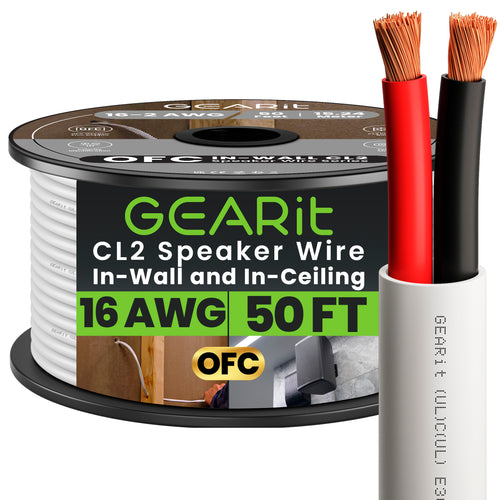Speaker wire color codes help identify positive and negative terminals, ensuring proper connections for clear sound quality. Common colors like red (positive) and black (negative) simplify setup, but knowing the specific coding ensures your audio system works flawlessly.
Upgrade your sound system with premium GearIT speaker wires:
Get crystal-clear sound and reliable performance—shop GearIT today and bring your audio to life! 🎶
When setting up an audio system, one of the key elements to achieving optimal sound quality is ensuring that your speaker wiring is done correctly. Mastering the speaker wire color code is essential for making accurate connections between your speakers and audio equipment. Miswiring can lead to poor sound performance or even damage to your components, so understanding the color coding system is crucial. In this blog, we will provide you with helpful tips to navigate the speaker wire color code and ensure your audio setup is both efficient and effective.
Whether you are a seasoned audiophile or a beginner looking to improve your home theater system, knowing how to interpret speaker wire colors will empower you to make informed decisions during installation. We’ll cover common color codes, wiring techniques, and best practices to help you achieve the best possible sound. Let’s learn the essentials of mastering speaker wire color code and elevate your audio experience!
Looking for quality speaker wire? Check out our selection of audio speaker wire to ensure you have the best options for your audio setup and enjoy superior sound quality.
What Are Speaker Wire Color Codes?

Speaker wire color codes are essential for identifying the correct connections in audio setups. By understanding these codes, you can ensure that you connect your speakers properly to avoid any damage or sound issues.
Fundamentals of Color Coding
Color coding serves as a visual guide for identifying positive and negative connections. Typically, a speaker wire consists of two conductors: one solid color and one striped. The most common combinations are red and black, where red indicates positive (+) and black signifies negative (-).
In other setups, you may encounter different colors such as white, green, or blue. For instance, white can serve as a secondary positive wire, while green often acts as an additional negative wire. Familiarizing yourself with these color schemes can help you avoid errors during installation.
Deciphering Polarity and Conductors
Understanding polarity is crucial for optimal audio performance. Connecting wires incorrectly can lead to phase issues, resulting in poor sound quality or damage to your audio equipment.
When connecting your speaker wires, always reference the terminals: red for positive (+) and black for negative (-). If your wire has additional colors, ensure you confirm their purpose by checking the manufacturer's guidelines or product manuals.
Ensuring correct polarity not only preserves sound integrity but also protects your speakers from potential harm. Investing time in properly identifying these wires pays off in the long run.
Standard Color Codes for Different Brands
While red and black are the most recognized color codes across many brands, variations exist. Here’s a brief overview of the standard color codes you might encounter:
|
Color |
Function |
|
Red |
Positive (+) connection |
|
Black |
Negative (-) connection |
|
White |
Secondary positive connection |
|
Green |
Additional negative connection |
|
Blue |
Often used in multi-channel setups. |
Different manufacturers may use unique combinations; hence, always consult the equipment’s manual for specific guidance. Identifying these codes can prevent costly mistakes when setting up your audio system.
The Importance of Proper Connection
Ensuring proper connection of speaker wires is essential for achieving optimal sound quality. Incorrectly connecting positive and negative wires can lead to phase issues and product malfunctions. It is important to be aware of these problems to maintain your audio system's performance.
Avoiding Phase Issues
Phase issues arise when speaker wires are connected with reversed polarity. This typically occurs when the positive wire (often red) is connected to the negative terminal of the amplifier, while the negative wire (often black) connects to the positive terminal.
A common symptom of phase problems is a lack of bass response and a hollow sound. To avoid this, always double-check your connections before powering on your system.
Use a multimeter to ensure polarity is correct. Keeping your user manual handy can also provide specific guidance on wire connections, which helps prevent confusion.
Preventing Short Circuits
Properly connecting speaker wires is crucial for preventing short circuits. Short circuits can occur if positive and negative wires touch each other. This may lead to blown amplifiers or speakers, causing costly replacements.
To minimize risks, secure wires to prevent them from crossing. Utilize wire management techniques, such as tying up excess wire and using cable organizers.
Always refer to the user manual for specific instructions on wiring your audio system. Regularly inspect your connections to ensure they remain secure and free from wear or damage. Taking these precautions goes a long way in maintaining your audio equipment's longevity and efficiency.
Speaker Wire Gauge and Resistance

The gauge of your speaker wire is essential for maintaining sound quality and minimizing resistance. Understanding how to match wire gauge to your audio setup will help ensure optimal performance without signal degradation.
Matching Gauge to Audio Setup
When selecting speaker wire, gauge plays a crucial role. The lower the gauge number, the thicker the wire. Thicker wires have lower resistance, making them suitable for longer distances or high-power applications.
Recommended Gauge Chart:
|
Distance (feet) |
Recommended Gauge |
|
Up to 50 |
16 |
|
50 to 100 |
14 |
|
100 to 150 |
12 |
Selecting the appropriate gauge ensures that your audio system transmits power efficiently. Choosing a thicker wire for extensive setups can reduce signal loss, enhancing overall sound performance.
Impact on Sound Performance
Using the correct wire gauge directly affects sound quality. Higher resistance in thinner wires can lead to signal degradation, resulting in diminished audio clarity.
Oxygen-free copper (OFC) wire is often preferred for its excellent conductivity and resistance to corrosion, further improving sound fidelity. In long runs, even slight resistance can alter sound dynamics, making it critical to choose the right gauge.
Investing in thicker cables can prevent current loss, ensuring that your audio remains crisp and engaging, regardless of the setup size.
Need a safe in-wall solution? Explore our range of CL3 speaker wire designed for in-wall installations, providing fire safety while delivering excellent audio performance.
Materials and Construction of Speaker Wires
The choice of materials and construction techniques significantly impacts the performance and durability of speaker wires. Understanding these factors helps you select the right wire for your audio needs.
Conductivity and Purity
Copper is the most commonly used material for speaker wires due to its excellent conductivity and affordability. Stranded copper wires offer flexibility, which makes installation easier, especially in tight spaces. You may also encounter oxygen-free copper (OFC), which has reduced oxidation for improved conductivity and longevity.
Another option is silver wire, known for its superior conductivity compared to copper. However, silver wires are generally more expensive and less flexible. Gold, though rarely used for the entirety of speaker wires, serves well in connectors due to its corrosion resistance. When selecting wires, look for purity levels that maximize performance and minimize signal loss.
Insulation and Shielding Against Noise
The insulation of speaker wires plays a critical role in protecting the conductive materials beneath. Common insulation materials include PVC and polyethylene, which prevent short circuits and damage. The thickness and quality of the insulation can vary, affecting durability and flexibility.
Shielding is another essential feature, especially in environments with potential interference. Some speaker wires come with braided shields or foil shields to block external electromagnetic noise. This ensures cleaner sound quality. Selecting well-insulated and shielded wires enhances performance, allowing you to enjoy optimal audio clarity without disruptions.
Best Practices for Speaker Wire Installation
Installing speaker wire properly is essential for optimal audio performance. Pay attention to the tools and techniques you use, as well as ensuring secure and stable connections.
Tools and Techniques
Having the right tools can significantly enhance your speaker wire installation process. Essential tools include:
- Wire Stripper: For removing insulation from the wire ends without damaging the conductors.
- Crimping Tool: If using connectors like banana plugs or spade connectors, a crimping tool ensures a firm electrical connection.
- Screwdriver: Needed to secure wires to terminals on your receiver or amplifier.
When choosing your speaker wire, consider the gauge as well. 14 or 16 gauge wire is commonly recommended for most home audio systems. Ensure you identify the positive (usually red or white) and negative (usually black) terminals correctly before you start. Miswiring can lead to sound issues.
Ensuring Secure and Stable Connections
To achieve the best sound quality, create solid connections at your receiver, amplifier, and stereo speakers. Follow these tips:
-
Tighten Connections: Ensure that wires attached to the terminals are secured tightly. Loose connections can cause distortion or signal loss.
-
Use Quality Connectors: Implementing banana plugs or spade connectors can provide a better grip and eliminate the need to twist wire around screws.
-
Check Polarity: Always double-check that you have consistently connected positive to positive and negative to negative. Miswiring can lead to phase issues that negatively impact audio quality.
- Avoid Overstretching Wires: Make sure that wires have enough slack to prevent stress on connections, especially around corners or obstacles.
Considering a reliable option? Discover our collection of CL2 speaker wire that meets safety standards for in-wall use, perfect for your audio needs.
Conclusion
Mastering the speaker wire color code is essential for ensuring accurate wiring and optimal sound quality in your audio system. By understanding the significance of each color and following proper wiring techniques, you can avoid common pitfalls and enhance your listening experience. Whether you're setting up a home theater or upgrading your car audio system, knowing how to interpret speaker wire colors will empower you to make informed decisions during installation.
If you're ready to take your audio setup to the next level, explore our collection of home theater and car speaker wire. With high-quality options available, you can find the perfect speaker wire to suit your needs and enjoy exceptional sound performance. Start shopping today and elevate your audio experience!
Frequently Asked Questions
What color speaker wires are positive and negative?
Typically, red wires indicate the positive connection, while black wires signify the negative. Some setups may use different colors, such as white for positive or green for negative, so always verify with your equipment's manual.
What happens if you mix up positive and negative speaker wires?
Mixing up the positive and negative wires can result in poor sound quality. Your speakers may sound distorted, or you might not get sound at all. In some cases, it can also damage your audio equipment.
What are the 4 colors of speaker wire?
The most commonly used colors are red, black, white, and green. Red usually denotes positive, black is for negative, white can serve as a secondary positive, and green may indicate an additional negative wire. Check your specific equipment for any variations.
What happens if you wire speakers backwards?
If you wire speakers backwards, also known as reversing polarity, the audio may sound out of phase. This can result in a decrease in bass response and a generally hollow sound, affecting your listening experience.
How to identify speaker wires?
You can identify speaker wires by looking at the color coding. Typically, one wire will be solid color (like red) and the other will be striped (like black). Removing insulation can also help you see the colors clearly.
Can I use any copper wire for speakers?
You can use copper wire for speakers, but it's best to use wires designed for audio. Speaker wire is made to minimize signal loss and prevent interference, which ensures better sound quality.





























































